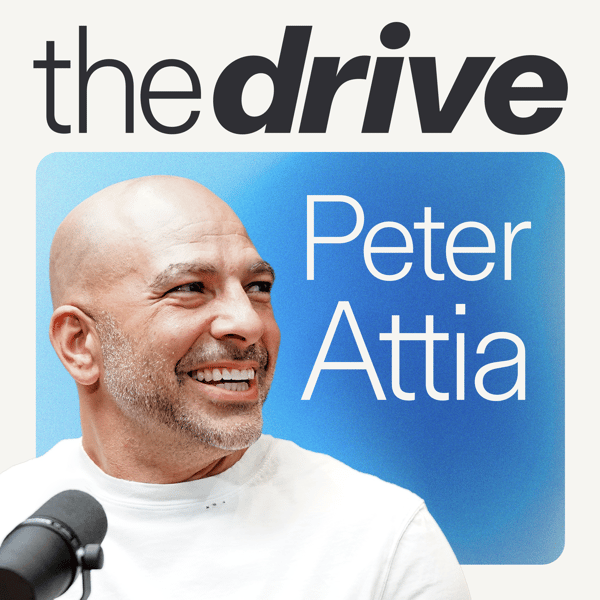#179 - Jeremy Loenneke, Ph.D.: The science of blood flow restriction—benefits, uses, and what it teaches us about the relationship between muscle size and strength
The Peter Attia Drive
Peter Attia, MD
4.7 • 7.3K Ratings
🗓️ 11 October 2021
⏱️ 119 minutes
🧾️ Download transcript
Summary
Jeremy Loenneke has a Ph.D. in exercise physiology, a Master’s in nutrition and exercise, and is currently the director of the Kevser Ermin Applied Physiology Laboratory at the University of Mississippi, where he focuses his research on skeletal muscle adaptations to exercise in combination with blood flow restriction (BFR). In this episode, Jeremy explains the science of BFR and the mechanisms by which BFR training can produce hypertrophy using low loads. Here, he reviews anatomy and terminology of muscle structure and discusses the evidence that increasing muscular strength may not be dependent on increasing muscle size. Additionally, Jeremy goes into depth on how one might take advantage of BFR training, including practical applications for athletes and average people, as well as the situations for which BFR training would be most advantageous.
We discuss:
- Jeremy’s interest in exercise and weightlifting and his scientific training [3:30];
- The microstructure and physiology of muscle [8:00];
- Definitions of fast-twitch and slow-twitch muscle fibers [12:45];
- Comparison of strength vs. hypertrophy [21:30];
- Blood flow restriction training and the origins of the Kaatsu system [28:30];
- The details and metrics related to exercise under blood flow restriction [44:45];
- Considerations when training with blood flow restriction: loading, pace, rest, and risks [53:00];
- Blood flow restriction studies and the relationship between muscle size and muscle strength [1:04:15];
- Evidence that increasing muscular strength is not dependent on increasing the size of the muscle [1:16:30];
- Practical applications of blood flow restriction training for athletes and average people [1:27:30];
- Situations in which blood flow restriction training is most advantageous [1:35:30];
- The mechanisms by which blood flow restriction training can produce so much hypertrophy at such low loads [1:39:45];
- Applications of “passive” blood flow restriction training [1:47:15];
- What experiments would Jeremy do if he had unlimited resources? [1:51:45];
- More.
Learn more: https://peterattiamd.com/
Show notes page for this episode: https://peterattiamd.com/JeremyLoenneke
Subscribe to receive exclusive subscriber-only content: https://peterattiamd.com/subscribe/
Sign up to receive Peter's email newsletter: https://peterattiamd.com/newsletter/
Connect with Peter on Facebook | Twitter | Instagram.
Transcript
Click on a timestamp to play from that location
| 0:00.0 | Hey everyone, welcome to the Drive Podcast. |
| 0:13.0 | I'm your host, Peter Atia. |
| 0:14.8 | This podcast, my website, and my weekly newsletter, all focus on the goal of translating |
| 0:18.7 | the science of longevity into something accessible for everyone. |
| 0:22.4 | Our goal is to provide the best content in health and wellness, full stop, and we've assembled |
| 0:27.0 | a great team of analysts to make this happen. |
| 0:29.4 | If you enjoy this podcast, we've created a membership program that brings you far more |
| 0:33.2 | in depth content if you want to take your knowledge of this space to the next level. |
| 0:37.3 | At the end of this episode, I'll explain what those benefits are, or if you want to learn |
| 0:41.0 | more now, head over to peteratiamd.com forward slash subscribe. |
| 0:46.3 | Now without further delay, here's today's episode. |
| 0:49.0 | I guess this week is Professor Jeremy Lonicy. |
| 0:53.7 | Jeremy is an associate professor of exercise science at the University of Mississippi, |
| 0:58.3 | better known as Ole Miss. |
| 1:00.3 | He has a PhD in exercise physiology from the University of Oklahoma and a masters in nutrition |
| 1:05.8 | and exercise from Southeast Missouri State University. |
| 1:09.8 | He's also a fellow of the American College of Sports Medicine and a member of the American |
| 1:15.2 | Physiological Society. |
| 1:17.1 | He's the director of an applied physiology laboratory and his research focuses on skeletal |
| 1:21.7 | muscle adaptations to exercise in combination with blood flow restriction. |
| 1:26.3 | Now, some of you may have seen me recently posting things on Instagram about blood flow |
| 1:31.9 | restriction. |
... |
Please login to see the full transcript.
Disclaimer: The podcast and artwork embedded on this page are from Peter Attia, MD, and are the property of its owner and not affiliated with or endorsed by Tapesearch.
Generated transcripts are the property of Peter Attia, MD and are distributed freely under the Fair Use doctrine. Transcripts generated by Tapesearch are not guaranteed to be accurate.
Copyright © Tapesearch 2025.

